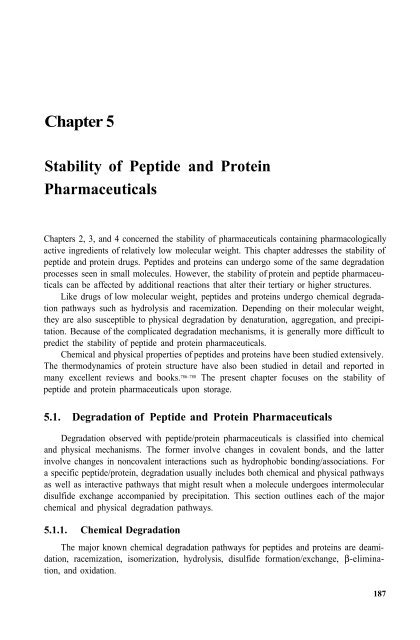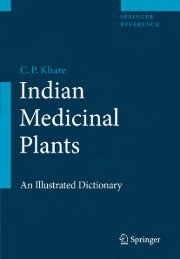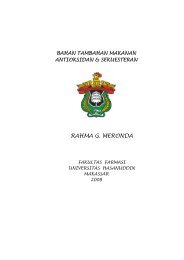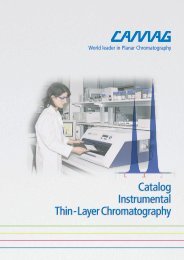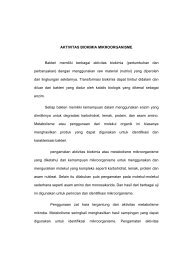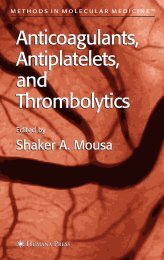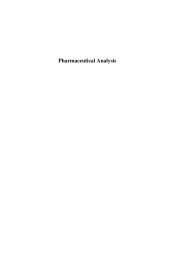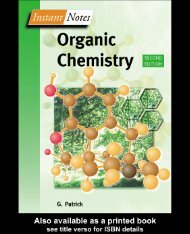Stability of Drugs and Dosage Forms Sumie Yoshioka
Stability of Drugs and Dosage Forms Sumie Yoshioka
Stability of Drugs and Dosage Forms Sumie Yoshioka
You also want an ePaper? Increase the reach of your titles
YUMPU automatically turns print PDFs into web optimized ePapers that Google loves.
Chapter 5<br />
<strong>Stability</strong> <strong>of</strong> Peptide <strong>and</strong> Protein<br />
Pharmaceuticals<br />
Chapters 2, 3, <strong>and</strong> 4 concerned the stability <strong>of</strong> pharmaceuticals containing pharmacologically<br />
active ingredients <strong>of</strong> relatively low molecular weight. This chapter addresses the stability <strong>of</strong><br />
peptide <strong>and</strong> protein drugs. Peptides <strong>and</strong> proteins can undergo some <strong>of</strong> the same degradation<br />
processes seen in small molecules. However, the stability <strong>of</strong> protein <strong>and</strong> peptide pharmaceuticals<br />
can be affected by additional reactions that alter their tertiary or higher structures.<br />
Like drugs <strong>of</strong> low molecular weight, peptides <strong>and</strong> proteins undergo chemical degradation<br />
pathways such as hydrolysis <strong>and</strong> racemization. Depending on their molecular weight,<br />
they are also susceptible to physical degradation by denaturation, aggregation, <strong>and</strong> precipitation.<br />
Because <strong>of</strong> the complicated degradation mechanisms, it is generally more difficult to<br />
predict the stability <strong>of</strong> peptide <strong>and</strong> protein pharmaceuticals.<br />
Chemical <strong>and</strong> physical properties <strong>of</strong> peptides <strong>and</strong> proteins have been studied extensively.<br />
The thermodynamics <strong>of</strong> protein structure have also been studied in detail <strong>and</strong> reported in<br />
many excellent reviews <strong>and</strong> books. 786–788 The present chapter focuses on the stability <strong>of</strong><br />
peptide <strong>and</strong> protein pharmaceuticals upon storage.<br />
5.1. Degradation <strong>of</strong> Peptide <strong>and</strong> Protein Pharmaceuticals<br />
Degradation observed with peptide/protein pharmaceuticals is classified into chemical<br />
<strong>and</strong> physical mechanisms. The former involve changes in covalent bonds, <strong>and</strong> the latter<br />
involve changes in noncovalent interactions such as hydrophobic bonding/associations. For<br />
a specific peptide/protein, degradation usually includes both chemical <strong>and</strong> physical pathways<br />
as well as interactive pathways that might result when a molecule undergoes intermolecular<br />
disulfide exchange accompanied by precipitation. This section outlines each <strong>of</strong> the major<br />
chemical <strong>and</strong> physical degradation pathways.<br />
5.1.1. Chemical Degradation<br />
The major known chemical degradation pathways for peptides <strong>and</strong> proteins are deamidation,<br />
racemization, isomerization, hydrolysis, disulfide formation/exchange, β -elimination,<br />
<strong>and</strong> oxidation.<br />
187


